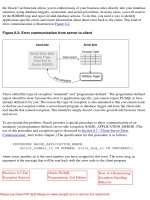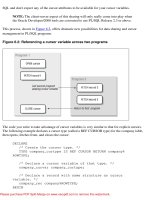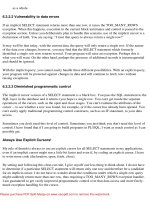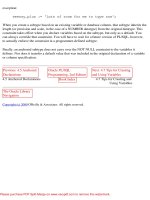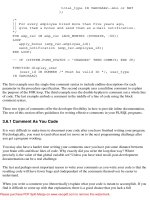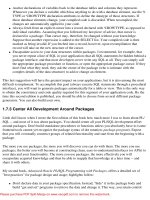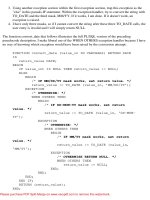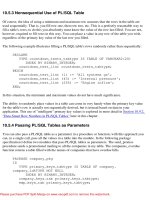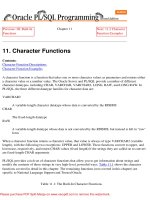oracle 9i sql reference
Bạn đang xem bản rút gọn của tài liệu. Xem và tải ngay bản đầy đủ của tài liệu tại đây (9.6 MB, 1,492 trang )
Oracle9
i
SQL Reference
Release 1 (9.0.1)
June 2001
Part No. A90125-01
Oracle9i SQL Reference, Release 1 (9.0.1)
Part No. A90125-01
Copyright © 1996, 2001, Oracle Corporation. All rights reserved.
Primary Author: Diana Lorentz
Contributors:
Nipun Agarwal, David Alpern, Patrick Amor, Rick Anderson, Geeta Arora, Nimar Arora,
Lance Ashdown, Cathy Baird, Sandeepan Banerjee, Cailein Barclay, Subrhansu Basu, Mark Bauer, Ruth Baylis,
Harmeek Bedi, Barbara Benton, Paula Bingham, Steve Bobrowski, Tolga Bozkaya, Allen Brumm, Bridget Burke,
Ted Burroughs, Greg Casbolt, Sivasankaran Chandrasekar, Thomas Chang, Eugene Chong, Greg Cook, Michele
Cyran, Ravindra Dani, Dinesh Das, Mary Ann Davidson , Norbert Debes, Connie Dialeris, Alan Downing, Amit
Ganesh, Bill Gietz, Govind Govindarajan, Ray Guzman, John Haydu, Shelley Higgins, Thuvan Hoang, Wei Hu,
Jiansheng Huang, Alexander Hunold, Bob Jenkins, Mark Johnson, Nitin Karkhanis, Vishy Karra, Jonathan
Klein, Susan Kotsovolos, Vishu Krishnamurthy, Ramkumar Krishnan, Muralidhar Krishnaprasad, Paul Lane,
Simon Law, Shilpa Lawande, Seong Yong Albert Lee, Bill Lee, Yunrui Li, Li-Sen Liu, Shih-Hao Liu, Jing Liu, Phil
Locke, Lenore Luscher, Kevin MacDowell, Steve McGee, Colin McGregor, Jack Melnick, Ben Meng, Magdi
Morsi, Ari Mozes, Sreedhar Mukkamalla, Subramanian Muralidhar, Ravi Murthy, Sujatha Muthulingam, Gary
Ngai, Ron Obermarck, Jeffrey Olkin, Kevin Osinski, Ananth Raghavan, Jack Raitto, Den Raphaely, Siva Ravada,
John Russell, Vivian Schupmann, Ajay Sethi, Lei Sheng, Wayne Smith, Ekrem Soylemez, Jagannathan
Srinivasan, Jim Stenoish, Mike Stewart, Seema Sundara, Ashish Thusoo, Rosanne Park Toohey, Anh-Tuan Tran,
Kothanda Umamageswaran, Randy Urbano, Sandy Venning, Andre Vergison, Steve Vivian, Eric Voss, Rick
Wessman, Daniel Wong, Aravind Yalamanchi, Adiel Yoaz, Qin Yu, Mohamed Zait, Fred Zemke, Mohamed
Ziauddin, and many many others.
The Programs (which include both the software and documentation) contain proprietary information of
Oracle Corporation; they are provided under a license agreement containing restrictions on use and
disclosure and are also protected by copyright, patent, and other intellectual and industrial property laws.
Reverse engineering, disassembly, or decompilation of the Programs is prohibited.
The information contained in this document is subject to change without notice. If you find any problems in
the documentation, please report them to us in writing. Oracle Corporation does not warrant that this
document is error free. Except as may be expressly permitted in your license agreement for these Programs,
no part of these Programs may be reproduced or transmitted in any form or by any means, electronic or
mechanical, for any purpose, without the express written permission of Oracle Corporation.
If the Programs are delivered to the U.S. Government or anyone licensing or using the programs on behalf of
the U.S. Government, the following notice is applicable:
Restricted Rights Notice Programs delivered subject to the DOD FAR Supplement are "commercial
computer software" and use, duplication, and disclosure of the Programs, including documentation, shall be
subject to the licensing restrictions set forth in the applicable Oracle license agreement. Otherwise, Programs
delivered subject to the Federal Acquisition Regulations are "restricted computer software" and use,
duplication, and disclosure of the Programs shall be subject to the restrictions in FAR 52.227-19, Commercial
Computer Software - Restricted Rights (June, 1987). Oracle Corporation, 500 Oracle Parkway, Redwood City,
CA 94065.
The Programs are not intended for use in any nuclear, aviation, mass transit, medical, or other inherently
dangerous applications. It shall be the licensee's responsibility to take all appropriate fail-safe, backup,
redundancy, and other measures to ensure the safe use of such applications if the Programs are used for
such purposes, and Oracle Corporation disclaims liability for any damages caused by such use of the
Programs.
Oracle is a registered trademark, and Oracle9i, Oracle Call Interface, Oracle Database Configuration
Assistant, Oracle Enterprise Manager, Oracle interMedia, Oracle Net, Oracle Spatial, Oracle Store, Oracle
Text, Oracle Trace, PL/SQL, Real Application Clusters, and SQL*Plus
are trademarks or registered
trademarks of Oracle Corporation. Other names may be trademarks of their respective owners.
iii
Contents
Send Us Your Comments xv
Preface xvii
What’s New in the SQL Reference? xxvii
1 Introduction
2 Basic Elements of Oracle SQL
Datatypes 2-2
Literals 2-51
Format Models 2-59
Nulls 2-77
Pseudocolumns 2-79
Comments 2-85
Database Objects 2-102
Schema Object Names and Qualifiers 2-106
Syntax for Schema Objects and Parts in SQL Statements 2-111
3 Operators
About SQL Operators 3-2
Arithmetic Operators 3-3
Concatenation Operator 3-4
Set Operators 3-6
iv
User-Defined Operators 3-6
4 Expressions
About SQL Expressions 4-2
Simple Expressions 4-3
Compound Expressions 4-4
CASE Expressions 4-5
CURSOR Expressions 4-7
Datetime Expressions 4-9
Function Expressions 4-11
INTERVAL Expressions 4-11
Object Access Expressions 4-12
Scalar Subquery Expressions 4-13
Type Constructor Expressions 4-13
Variable Expressions 4-15
Expression List 4-15
5 Conditions
About SQL Conditions 5-2
Comparison Conditions 5-4
Logical Conditions 5-7
Membership Conditions 5-9
Range Conditions 5-11
Null Conditions 5-11
EXISTS Conditions 5-11
LIKE Conditions 5-12
IS OF type Conditions 5-16
Compound Conditions 5-17
6 Functions
SQL Functions 6-2
ABS 6-15
ACOS 6-15
ADD_MONTHS 6-16
v
ASCII 6-16
ASCIISTR 6-17
ASIN 6-18
ATAN 6-19
ATAN2 6-19
AV G 6-20
BFILENAME 6-21
BIN_TO_NUM 6-22
BITAND 6-23
CAST 6-24
CEIL 6-27
CHARTOROWID 6-27
CHR 6-28
COALESCE 6-29
COMPOSE 6-31
CONCAT 6-31
CONVERT 6-32
CORR 6-34
COS 6-36
COSH 6-36
COUNT 6-37
COVAR_POP 6-39
COVAR_SAMP 6-41
CUME_DIST 6-43
CURRENT_DATE 6-45
CURRENT_TIMESTAMP 6-46
DBTIMEZONE 6-47
DECODE 6-47
DECOMPOSE 6-49
DENSE_RANK 6-50
DEREF 6-52
DUMP 6-53
EMPTY_BLOB, EMPTY_CLOB 6-55
EXISTSNODE 6-55
EXP 6-56
vi
EXTRACT (datetime) 6-57
EXTRACT (XML) 6-58
FIRST 6-59
FIRST_VALUE 6-61
FLOOR 6-63
FROM_TZ 6-63
GREATEST 6-64
GROUP_ID 6-65
GROUPING 6-66
GROUPING_ID 6-67
HEXTORAW 6-69
INITCAP 6-69
INSTR 6-70
LAG 6-72
LAST 6-73
LAST_DAY 6-75
LAST_VALUE 6-76
LEAD 6-78
LEAST 6-80
LENGTH 6-80
LN 6-81
LOCALTIMESTAMP 6-82
LOG 6-83
LOWER 6-83
LPAD 6-84
LTRIM 6-85
MAKE_REF 6-85
MAX 6-86
MIN 6-89
MOD 6-90
MONTHS_BETWEEN 6-91
NCHR 6-92
NEW_TIME 6-93
NEXT_DAY 6-94
NLS_CHARSET_DECL_LEN 6-94
vii
NLS_CHARSET_ID 6-95
NLS_CHARSET_NAME 6-96
NLS_INITCAP 6-96
NLS_LOWER 6-98
NLSSORT 6-99
NLS_UPPER 6-100
NTILE 6-101
NULLIF 6-102
NUMTODSINTERVAL 6-103
NUMTOYMINTERVAL 6-104
NVL 6-105
NVL2 6-106
PERCENT_RANK 6-107
PERCENTILE_CONT 6-109
PERCENTILE_DISC 6-112
POWER 6-113
RANK 6-114
RATIO_TO_REPORT 6-116
RAWTOHEX 6-117
RAWTONHEX 6-118
REF 6-118
REFTOHEX 6-119
REGR_ (linear regression) functions 6-120
REPLACE 6-128
ROUND (number) 6-129
ROUND (date) 6-130
ROW_NUMBER 6-131
ROWIDTOCHAR 6-132
ROWIDTONCHAR 6-133
RPAD 6-133
RTRIM 6-134
SESSIONTIMEZONE 6-135
SIGN 6-135
SIN 6-136
SINH 6-136
viii
SOUNDEX 6-137
SQRT 6-138
STDDEV 6-139
STDDEV_POP 6-140
STDDEV_SAMP 6-142
SUBSTR 6-144
SUM 6-145
SYS_CONNECT_BY_PATH 6-147
SYS_CONTEXT 6-148
SYS_DBURIGEN 6-153
SYS_EXTRACT_UTC 6-154
SYS_GUID 6-155
SYS_TYPEID 6-156
SYS_XMLAGG 6-157
SYS_XMLGEN 6-158
SYSDATE 6-159
SYSTIMESTAMP 6-160
TAN 6-161
TANH 6-161
TO_CHAR (character) 6-162
TO_CHAR (datetime) 6-163
TO_CHAR (number) 6-165
TO_CLOB 6-167
TO_DATE 6-167
TO_DSINTERVAL 6-168
TO_LOB 6-169
TO_MULTI_BYTE 6-170
TO_NCHAR (character) 6-171
TO_NCHAR (datetime) 6-172
TO_NCHAR (number) 6-173
TO_NCLOB 6-174
TO_NUMBER 6-174
TO_SINGLE_BYTE 6-175
TO_TIMESTAMP 6-176
TO_TIMESTAMP_TZ 6-177
ix
TO_YMINTERVAL 6-178
TRANSLATE 6-179
TRANSLATE USING 6-180
TREAT 6-182
TRIM 6-183
TRUNC (number) 6-184
TRUNC (date) 6-185
TZ_OFFSET 6-186
UID 6-187
UNISTR 6-187
UPPER 6-188
USER 6-189
USERENV 6-189
VALUE 6-191
VAR_POP 6-192
VAR_SAMP 6-194
VARIANCE 6-195
VSIZE 6-197
WIDTH_BUCKET 6-198
ROUND and TRUNC Date Functions 6-199
User-Defined Functions 6-201
7 SQL Queries and Other SQL Statements
Queries and Subqueries 7-2
Types of SQL Statements 7-16
8 SQL Statements:
ALTER CLUSTER to ALTER SEQUENCE
ALTER CLUSTER 8-3
ALTER DATABASE 8-9
ALTER DIMENSION 8-44
ALTER FUNCTION 8-48
ALTER INDEX 8-51
ALTER INDEXTYPE 8-72
ALTER JAVA 8-74
x
ALTER MATERIALIZED VIEW 8-77
ALTER MATERIALIZED VIEW LOG 8-93
ALTER OUTLINE 8-100
ALTER PACKAGE 8-102
ALTER PROCEDURE 8-106
ALTER PROFILE 8-109
ALTER RESOURCE COST 8-113
ALTER ROLE 8-116
ALTER ROLLBACK SEGMENT 8-118
ALTER SEQUENCE 8-122
9 SQL Statements:
ALTER SESSION to ALTER SYSTEM
ALTER SESSION 9-2
Initialization Parameters and ALTER SESSION 9-7
Session Parameters and ALTER SESSION 9-11
ALTER SYSTEM 9-20
Initialization Parameters and ALTER SYSTEM 9-33
10 SQL Statements:
ALTER TABLE to ALTER TABLESPACE
ALTER TABLE 10-2
ALTER TABLESPACE 10-82
11 SQL Statements:
ALTER TRIGGER to
constraint_clause
ALTER TRIGGER 11-2
ALTER TYPE 11-6
ALTER USER 11-20
ALTER VIEW 11-28
ANALYZE 11-31
ASSOCIATE STATISTICS 11-46
AUDIT 11-50
CALL 11-64
xi
COMMENT 11-67
COMMIT 11-70
constraint_clause 11-73
12 SQL Statements:
CREATE CLUSTER to CREATE JAVA
CREATE CLUSTER 12-2
CREATE CONTEXT 12-11
CREATE CONTROLFILE 12-14
CREATE DATABASE 12-20
CREATE DATABASE LINK 12-33
CREATE DIMENSION 12-39
CREATE DIRECTORY 12-44
CREATE FUNCTION 12-47
CREATE INDEX 12-60
CREATE INDEXTYPE 12-87
CREATE JAVA 12-90
13 SQL Statements:
CREATE LIBRARY to CREATE SPFILE
CREATE LIBRARY 13-2
CREATE MATERIALIZED VIEW 13-5
CREATE MATERIALIZED VIEW LOG 13-28
CREATE OPERATOR 13-37
CREATE OUTLINE 13-41
CREATE PACKAGE 13-45
CREATE PACKAGE BODY 13-50
CREATE PFILE 13-55
CREATE PROCEDURE 13-57
CREATE PROFILE 13-64
CREATE ROLE 13-71
CREATE ROLLBACK SEGMENT 13-74
CREATE SCHEMA 13-78
CREATE SEQUENCE 13-81
CREATE SPFILE 13-86
xii
14 SQL Statements:
CREATE SYNONYM to CREATE TRIGGER
CREATE SYNONYM 14-2
CREATE TABLE 14-6
CREATE TABLESPACE 14-66
CREATE TEMPORARY TABLESPACE 14-77
CREATE TRIGGER 14-81
15 SQL Statements:
CREATE TYPE to
DROP ROLLBACK SEGMENT
CREATE TYPE 15-3
CREATE TYPE BODY 15-23
CREATE USER 15-29
CREATE VIEW 15-36
DELETE 15-49
DISASSOCIATE STATISTICS 15-57
DROP CLUSTER 15-60
DROP CONTEXT 15-62
DROP DATABASE LINK 15-63
DROP DIMENSION 15-64
DROP DIRECTORY 15-66
DROP FUNCTION 15-67
DROP INDEX 15-69
DROP INDEXTYPE 15-71
DROP JAVA 15-73
DROP LIBRARY 15-75
DROP MATERIALIZED VIEW 15-76
DROP MATERIALIZED VIEW LOG 15-78
DROP OPERATOR 15-80
DROP OUTLINE 15-82
DROP PACKAGE 15-83
DROP PROCEDURE 15-85
DROP PROFILE 15-87
DROP ROLE 15-89
xiii
DROP ROLLBACK SEGMENT 15-90
16 SQL Statements:
DROP SEQUENCE to ROLLBACK
DROP SEQUENCE 16-2
DROP SYNONYM 16-4
DROP TABLE 16-6
DROP TABLESPACE 16-10
DROP TRIGGER 16-13
DROP TYPE 16-15
DROP TYPE BODY 16-18
DROP USER 16-20
DROP VIEW 16-22
EXPLAIN PLAN 16-24
filespec 16-28
GRANT 16-32
INSERT 16-54
LOCK TABLE 16-71
MERGE 16-75
NOAUDIT 16-79
RENAME 16-84
REVOKE 16-86
ROLLBACK 16-96
17 SQL Statements:
SAVEPOINT to UPDATE
SAVEPOINT 17-2
SELECT 17-4
SET CONSTRAINT[S] 17-40
SET ROLE 17-42
SET TRANSACTION 17-45
storage_clause 17-49
TRUNCATE 17-58
UPDATE 17-63
xiv
A How to Read Syntax Diagrams
B Oracle and Standard SQL
C Oracle Reserved Words
Index
xv
Send Us Your Comments
SQL Reference, Release 1 (9.0.1)
Part No. A90125-01
Oracle Corporation welcomes your comments and suggestions on the quality and usefulness of this
document. Your input is an important part of the information used for revision.
■ Did you find any errors?
■ Is the information clearly presented?
■ Do you need more information? If so, where?
■ Are the examples correct? Do you need more examples?
■ What features did you like most?
If you find any errors or have any other suggestions for improvement, please indicate the document
title and part number, and the chapter, section, and page number (if available). You can send com-
ments to us in the following ways:
■ Electronic mail:
■ FAX: (650) 506-7227 Attn: Server Technologies Documentation Manager
■ Postal service:
Oracle Corporation
Server Technologies Documentation
500 Oracle Parkway, Mailstop 4op11
Redwood Shores, CA 94065
USA
If you would like a reply, please give your name, address, telephone number, and (optionally) elec-
tronic mail address.
If you have problems with the software, please contact your local Oracle Support Services.
Preface
This reference contains a complete description of the Structured Query Language
(SQL) used to manage information in an Oracle database. Oracle SQL is a superset
of the American National Standards Institute (ANSI) and the International
Standards Organization (ISO) SQL99 standard.
This preface contains these topics:
■ Audience
■ Organization
■ Related Documentation
■ Conventions
■ Documentation Accessibility
xviii
Audience
The SQL Reference is intended for all users of Oracle SQL.
Organization
This reference is divided into the following parts:
Volume 1
Chapter 1, "Introduction"
This chapter discusses the history of SQL and describes the advantages of using it
to access relational databases.
Chapter 2, "Basic Elements of Oracle SQL"
This chapter describes the basic building blocks of an Oracle database and of
Oracle SQL.
Chapter 3, "Operators"
This chapter describes SQL operators.
Chapter 4, "Expressions"
This chapter describes SQL expressions.
Chapter 5, "Conditions"
This chapter describes SQL conditions.
Chapter 6, "Functions"
This chapter describes how to use SQL functions.
Chapter 7, "SQL Queries and Other SQL Statements"
This chapter describes the different types of SQL queries and lists the various types
of SQL statements.
xix
Volume 2
Chapter 8, "SQL Statements: ALTER CLUSTER to ALTER SEQUENCE"
Chapter 9, "SQL Statements: ALTER SESSION to ALTER SYSTEM"
Chapter 10, "SQL Statements: ALTER TABLE to ALTER TABLESPACE"
Chapter 11, "SQL Statements: ALTER TRIGGER to constraint_clause"
Chapter 12, "SQL Statements: CREATE CLUSTER to CREATE JAVA"
Chapter 13, "SQL Statements: CREATE LIBRARY to CREATE SPFILE"
Chapter 14, "SQL Statements: CREATE SYNONYM to CREATE TRIGGER"
Chapter 15, "SQL Statements: CREATE TYPE to DROP ROLLBACK
SEGMENT"
Chapter 16, "SQL Statements: DROP SEQUENCE to ROLLBACK"
Chapter 17, "SQL Statements: SAVEPOINT to UPDATE"
These chapters list and describe all Oracle SQL statements in alphabetical order.
Appendix A, "How to Read Syntax Diagrams"
This appendix describes how to read the syntax diagrams in this reference.
Appendix B, "Oracle and Standard SQL"
This appendix describes Oracle compliance with ANSI and ISO standards.
Appendix C, "Oracle Reserved Words"
This appendix lists words that are reserved for internal use by Oracle.
Structural Changes in the SQL Reference in Oracle9
i
Release 1 (9.0.1)
The chapter that formerly described expressions, conditions, and queries has been
divided. Conditions and expressions are now two separate chapters, and queries
are described in Chapter 7, "SQL Queries and Other SQL Statements".
CAST, DECODE, and EXTRACT (datetime), which were formerly documented as
forms of expression, are now documented as SQL built-in functions.
LIKE and the elements formerly called "comparison operators" and "logical
operators" are now documented as SQL conditions.
The chapters containing all SQL statements (formerly Chapters 7 through 10) has
been divided into ten chapters for printing purposes.
xx
Structural Changes in the SQL Reference in Oracle8
i
The chapter containing all SQL statements (formerly Chapter 7) has been divided
into four chapters for printing purposes.
Users familiar with the Release 8.0 documentation will find that the following
sections have been moved or renamed:
■ The section "Format Models" now appears in Chapter 2 on page 2-59.
■ Chapter 3 has been divided into several smaller chapters:
■ Chapter 3, "Operators"
■ Chapter 6, "Functions"
■ Chapter 4, "Expressions". The last section, "Queries and Subqueries" on
page 5-26, provides background for the syntactic and semantic information
in SELECT on page 17-4.
■ A new chapter, Chapter 8, "About SQL Statements", has been added to help you
find the correct SQL statement for a particular task.
■ The
archive_log_clause
is no longer a separate section, but has been
incorporated into ALTER SYSTEM on page 9-20.
■ The
deallocate_unused_clause
is no longer a separate section, but has
been incorporated into ALTER TABLE on page 10-2, ALTER CLUSTER on
page 8-3, and ALTER INDEX on page 8-51.
■ The
disable_clause
is no longer a separate section, but has been
incorporated into CREATE TABLE on page 14-6 and ALTER TABLE on
page 10-2.
■ The
drop_clause
is no longer a separate section. It has become the
drop_
constraint_clause
of the ALTER TABLE statement (to distinguish it from
the new
drop_column_clause
of that statement). See ALTER TABLE on
page 10-2.
■ The
enable_clause
is no longer a separate section, but has been incorporated
into CREATE TABLE on page 14-6 and ALTER TABLE on page 10-2.
■ The
parallel_clause
is no longer a separate section. The clause has been
simplified, and has been incorporated into the various statements where it is
relevant.
■ The
recover_clause
is no longer a separate section. Recovery functionality
has been enhanced, and because it is always implemented through the ALTER
xxi
DATABASE statement, it has been incorporated into that section. See ALTER
DATABASE on page 8-9.
■ The sections on snapshots and snapshot logs have been moved and renamed.
Snapshot functionality has been greatly enhanced, and these objects are now
called materialized views. See CREATE MATERIALIZED VIEW on page 13-5,
ALTER MATERIALIZED VIEW on page 8-77, DROP MATERIALIZED VIEW on
page 15-76, CREATE MATERIALIZED VIEW LOG on page 13-28, ALTER
MATERIALIZED VIEW LOG on page 8-93, and DROP MATERIALIZED VIEW
LOG on page 15-78.
■ The section on subqueries has now been combined with the SELECT statement.
See SELECT on page 17-4.
■ The two SQL statements GRANT
object_privileges
and GRANT
system_
privileges_and_roles
have been combined into one GRANT statement. See
GRANT on page 16-32.
■ The two SQL statements REVOKE
schema_object_privileges
and REVOKE
system_privileges_and_roles
have been combined into one REVOKE
statement. See REVOKE on page 16-86.
■ The two SQL statements AUDIT
sql_statements
and AUDIT
schema_
objects
have been combined into one AUDIT statement. See AUDIT on
page 11-50.
■ The two SQL statements NOAUDIT
sql_statements
and NOAUDIT
schema_
objects
have been combined into one NOAUDIT statement. See NOAUDIT on
page 16-79.
Related Documentation
For more information, see these Oracle resources:
■ PL/SQL User’s Guide and Reference for information on PL/SQL, Oracle’s
procedural language extension to SQL
■ Pro*C/C++ Precompiler Programmer’s Guide, SQL*Module for Ada Programmer’s
Guide, and the Pro*COBOL Precompiler Programmer’s Guide for detailed
descriptions of Oracle embedded SQL
Many of the examples in this book use the sample schemas of the seed database,
which is installed by default when you install Oracle. Refer to Oracle9i Sample
Schemas for information on how these schemas were created and how you can use
them yourself.
xxii
In North America, printed documentation is available for sale in the Oracle Store at
/>Customers in Europe, the Middle East, and Africa (EMEA) can purchase
documentation from
/>Other customers can contact their Oracle representative to purchase printed
documentation.
To download free release notes, installation documentation, white papers, or other
collateral, please visit the Oracle Technology Network (OTN). You must register
online before using OTN; registration is free and can be done at
/>If you already have a username and password for OTN, then you can go directly to
the documentation section of the OTN Web site at
/>Conventions
This section describes the conventions used in the text and code examples of this
documentation set. It describes:
■ Conventions in Text
■ Conventions in Code Examples
Conventions in Text
We use various conventions in text to help you more quickly identify special terms.
The following table describes those conventions and provides examples of their use.
Convention Meaning Example
Bold Bold typeface indicates terms that are
defined in the text or terms that appear in
a glossary, or both.
When you specify this clause, you create an
index-organized table.
Italics Italic typeface indicates book titles or
emphasis.
Oracle9i Database Concepts
Ensure that the recovery catalog and target
database do not reside on the same disk.
xxiii
Conventions in Code Examples
Code examples illustrate SQL, PL/SQL, SQL*Plus, or other command-line
statements. They are displayed in a monospace (fixed-width) font and separated
from normal text as shown in this example:
SELECT username FROM dba_users WHERE username = ’MIGRATE’;
The following table describes typographic conventions used in code examples and
provides examples of their use.
UPPERCASE
monospace
(fixed-width
font)
Uppercase monospace typeface indicates
elements supplied by the system. Such
elements include parameters, privileges,
datatypes, RMAN keywords, SQL
keywords, SQL*Plus or utility commands,
packages and methods, as well as
system-supplied column names, database
objects and structures, usernames, and
roles.
You can specify this clause only for a NUMBER
column.
You can back up the database by using the
BACKUP command.
Query the TABLE_NAME column in the USER_
TABLES data dictionary view.
Use the DBMS_STATS.GENERATE_STATS
procedure.
lowercase
monospace
(fixed-width
font)
Lowercase monospace typeface indicates
executables, filenames, directory names,
and sample user-supplied elements. Such
elements include computer and database
names, net service names, and connect
identifiers, as well as user-supplied
database objects and structures, column
names, packages and classes, usernames
and roles, program units, and parameter
values.
Note: Some programmatic elements use a
mixture of UPPERCASE and lowercase.
Enter these elements as shown.
Enter sqlplus to open SQL*Plus.
The password is specified in the orapwd file.
Back up the datafiles and control files in the
/disk1/oracle/dbs directory.
The department_id, department_name,
and location_id columns are in the
hr.departments table.
Set the QUERY_REWRITE_ENABLED
initialization parameter to true.
Connect as oe user.
The JRepUtil class implements these
methods.
lowercase
monospace
(fixed-width
font) italic
Lowercase monospace italic font
represents placeholders or variables.
You can specify the
parallel_clause
.
Run U
old_release
.SQL where
old_
release
refers to the release you installed
prior to upgrading.
Convention Meaning Example
xxiv
Convention Meaning Example
[ ] Brackets enclose one or more optional
items. Do not enter the brackets.
DECIMAL (
digits
[ ,
precision
])
{ }
Braces enclose two or more items, one of
which is required. Do not enter the
braces.
{ENABLE | DISABLE}
|
A vertical bar represents a choice of two
or more options within brackets or braces.
Enter one of the options. Do not enter the
vertical bar.
{ENABLE | DISABLE}
[COMPRESS | NOCOMPRESS]
Horizontal ellipsis points indicate either:
■ That we have omitted parts of the
code that are not directly related to
the example
■ That you can repeat a portion of the
code
CREATE TABLE AS
subquery
;
SELECT
col1
,
col2
, ,
coln
FROM
employees;
.
.
.
Vertical ellipsis points indicate that we
have omitted several lines of code not
directly related to the example.
Other notation You must enter symbols other than
brackets, braces, vertical bars, and ellipsis
points as shown.
acctbal NUMBER(11,2);
acct CONSTANT NUMBER(4) := 3;
Italics
Italicized text indicates placeholders or
variables for which you must supply
particular values.
CONNECT SYSTEM/
system_password
DB_NAME =
database_name
UPPERCASE Uppercase typeface indicates elements
supplied by the system. We show these
terms in uppercase in order to distinguish
them from terms you define. Unless terms
appear in brackets, enter them in the
order and with the spelling shown.
However, because these terms are not
case sensitive, you can enter them in
lowercase.
SELECT last_name, employee_id FROM
employees;
SELECT * FROM USER_TABLES;
DROP TABLE hr.employees;
xxv
Documentation Accessibility
Oracle's goal is to make our products, services, and supporting documentation
accessible to the disabled community with good usability. To that end, our
documentation includes features that make information available to users of
assistive technology. This documentation is available in HTML format, and contains
markup to facilitate access by the disabled community. Standards will continue to
evolve over time, and Oracle is actively engaged with other market-leading
technology vendors to address technical obstacles so that our documentation can be
accessible to all of our customers. For additional information, visit the Oracle
Accessibility Program Web site at
/>JAWS, a Windows screen reader, may not always correctly read the code examples
in this document. The conventions for writing code require that closing braces
should appear on an otherwise empty line; however, JAWS may not always read a
line of text that consists solely of a bracket or brace.
lowercase Lowercase typeface indicates
programmatic elements that you supply.
For example, lowercase indicates names
of tables, columns, or files.
Note: Some programmatic elements use a
mixture of UPPERCASE and lowercase.
Enter these elements as shown.
SELECT last_name, employee_id FROM
employees;
sqlplus hr/hr
CREATE USER mjones IDENTIFIED BY ty3MU9;
Convention Meaning Example
